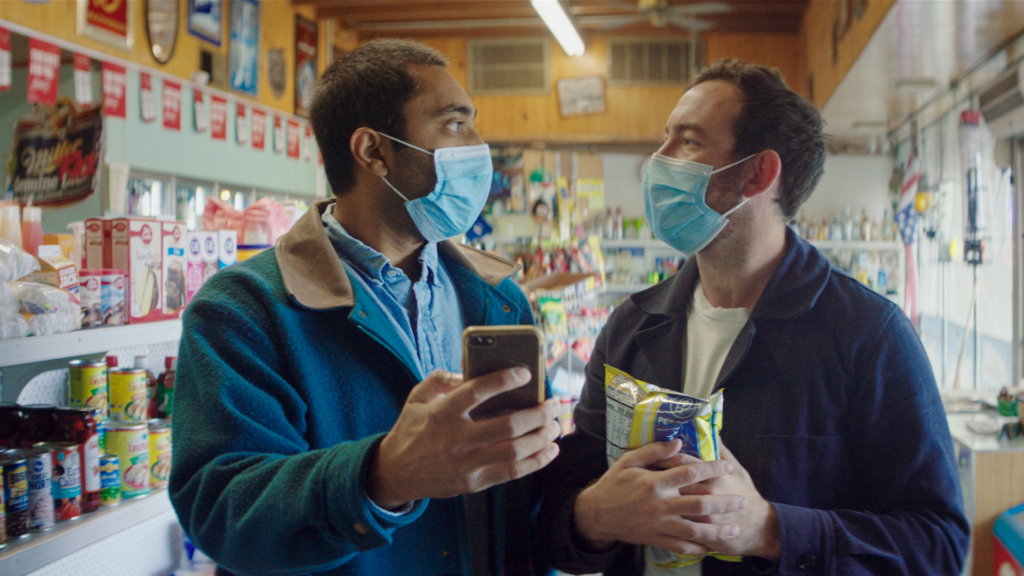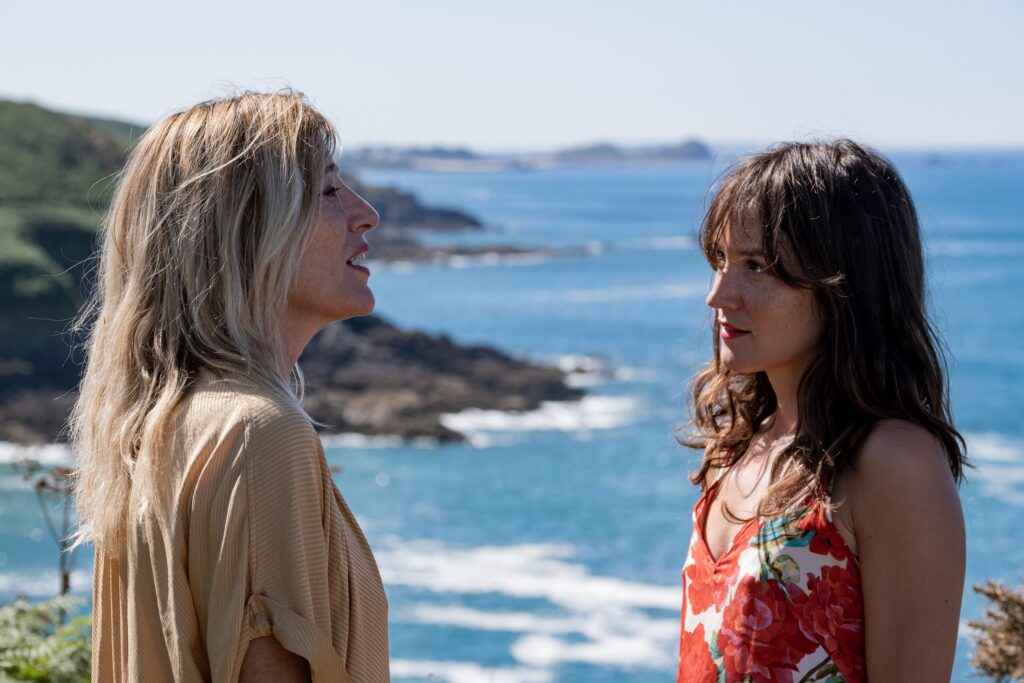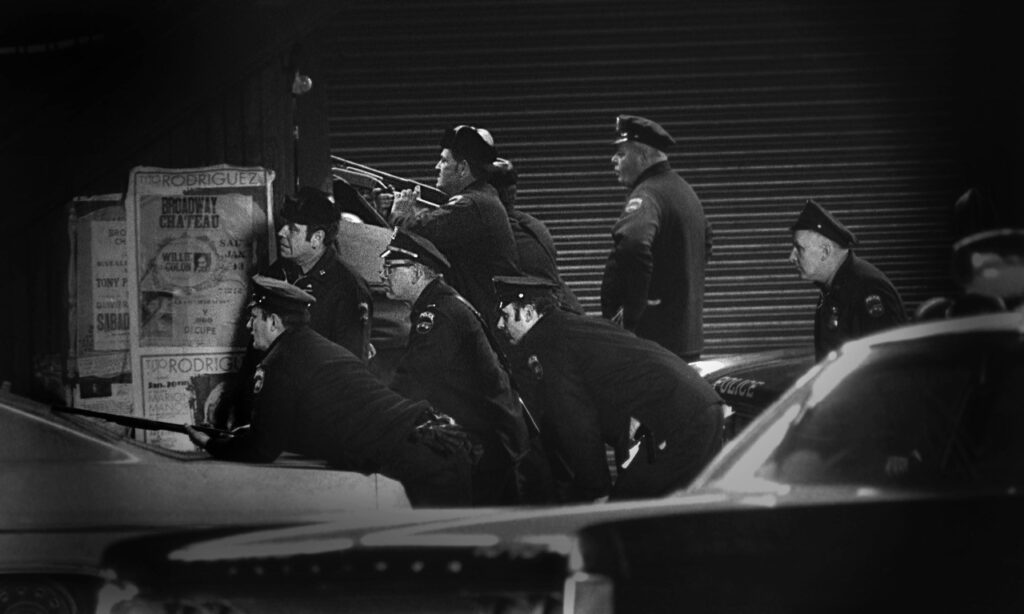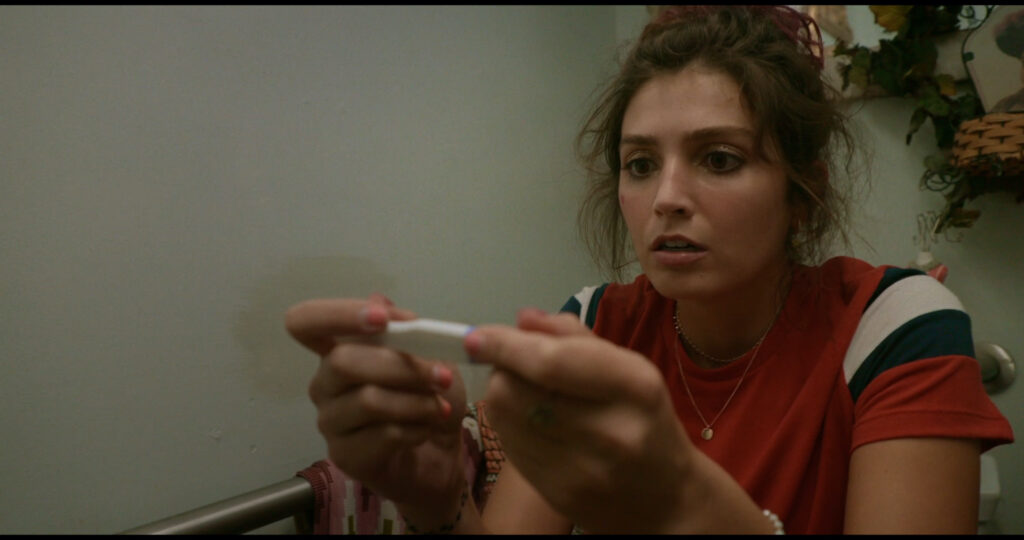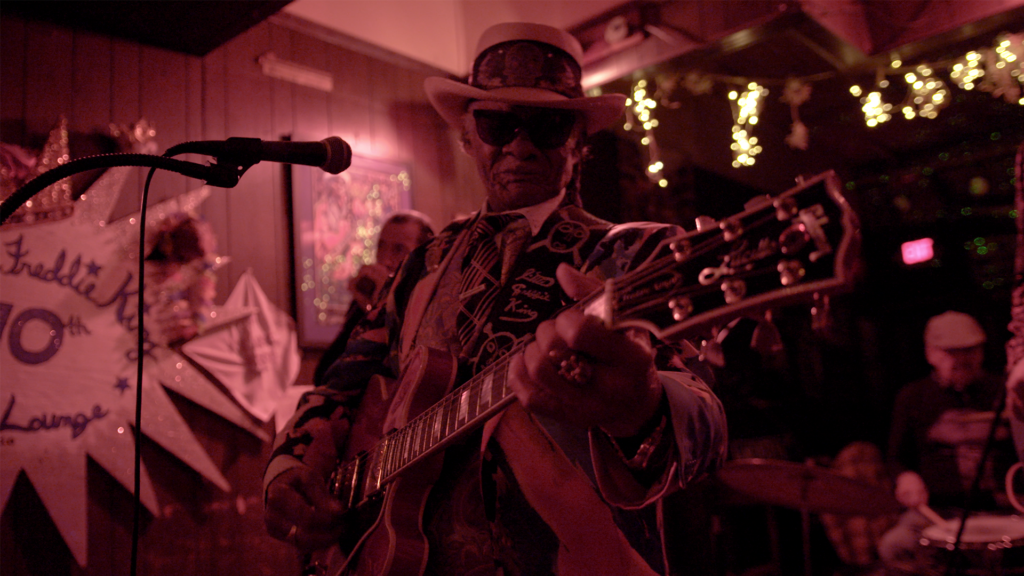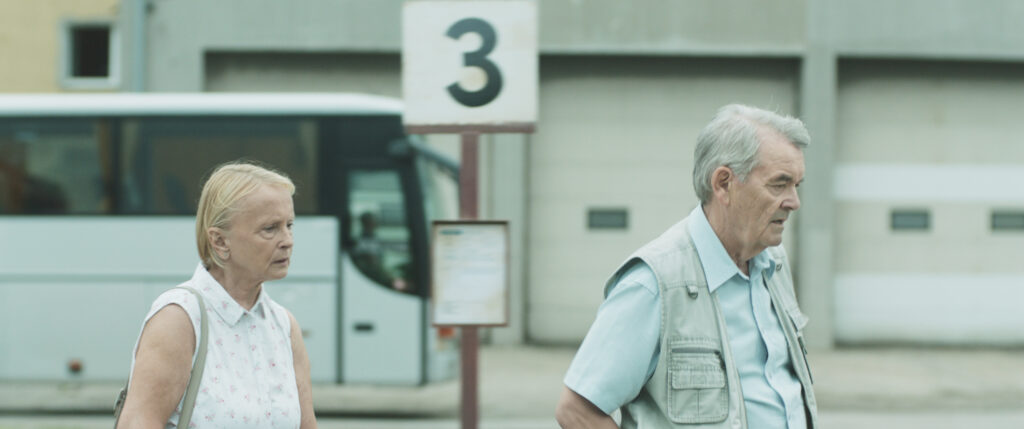July 9, 2022
by Carla Hay

Directed by Mariano Cohn and Gastón Duprat
Spanish with subtitles
Culture Representation: Taking place primarily in Madrid, Spain, the comedy/drama film “Official Competition” features a cast of Spanish characters representing the working-class, middle-class and wealthy.
Culture Clash: An eccentric filmmaker, who has been hired by a rich businessman to direct a movie, takes pleasure in playing mind games with the two famous actors whom she cast as co-stars in the movie.
Culture Audience: “Official Competition” will appeal primarily to people who are fans of stars Penélope Cruz and Antonio Banderas and films that have a satirical “movie within a movie” plot.

With a total running time of 115 minutes, “Official Competition” drags on for a little longer than it should, but this slightly offbeat comedy/drama has some sharp observations about how celebrities can be coddled and exploited in the movie industry. The movie shows in many acerbic ways how people will enable those with a certain level of fame and fortune to humiliate or bully others, in the name of creating “art.” There are no real heroes or villains in “Official Competition”—just a lot of very flawed and damaged people who have questionable (or no) boundaries.
Directed by Mariano Cohn and Gastón Duprat (who both co-wrote the screenplay with Andrés Duprat, Gastón’s older brother), “Official Competition” takes place in Madrid, but the themes in the movie are universal to wherever movies financed by wealthy people can be made. “Official Competition” made the rounds at several film festivals including the 2021 Venice International Film Festival (where the movie had its world premiere), the 2021 Toronto International Film Festival and the 2022 Tribeca Film Festival. In many ways, “Official Competition” is an incisive parody of rich people who think they can buy their way into artistic creativity and any accolades that come with it.
It’s why wealthy pharmaceutical tycoon Humberto Suárez (played by José Luis Gómez) decides to go into the movie business, shortly after his 80th birthday. Humberto wants his legacy to be more than just his success in the pharmaceutical industry. He wants the glamour and cachet of making a movie with famous filmmakers and celebrity actors.
After his 80th birthday party that was held at his company headquarters, Humberto asks a subordinate executive named Matías (played by Manolo Solo) how people perceive Humberto. Matías replies, “As a man who started from nothing, and today is a leader in the pharmaceutical industry, and feeds almost 10,000 families.”
Humberto says, “I’ll tell you how they see me: as a millionaire with an obscene fortune but without prestige … I want to be remembered differently.” Humberto contemplates either donating to the state a bridge named after himself, or financing a movie. He chooses to finance a movie.
Humberto decides to be a financial backer/producer for the latest movie of the artsiest filmmaker he can find. He wants someone who’s edgy enough to be considered innovative, but mainstream enough that this person is capable of winning prestigious awards. And the person whose name comes up immediately and whom he chooses is avant-garde filmmaker Lola Cuevas (played by Penélope Cruz), who is known for her extreme ways of rehearsing and making a movie.
Lola, who has been making movies since 1996, has a 2015 movie called “Haze,” which is considered her “masterpiece.” One of her quirks is that Lola doesn’t give interviews. Therefore, she doesn’t give a lot of public insight into her filmmaking process. By keeping an aura of mystery about herself, Lola has made herself more in demand to certain people who want to work with her.
Humberto meets with Lola, and he agrees to Lola’s demands that she have complete creative control over the movie. Lola hires the two actors who will be equal co-stars in the film that she’s writing and directing and which Humberto will be financing. These co-stars are Félix Rivero (played by Antonio Banderas) and Iván Torres (played by Oscar Martínez), who are opposites in many ways.
Félix, who is a restless bachelor playboy, is more caught up in being a movie star than in being a serious actor. And he has a filmography of commercial blockbusters to prove it. Iván, who’s been in a stable, longtime marriage, takes the craft of acting very seriously. Iván is famous for being in highly respected stage productions that don’t necessarily make a lot of money but they are often award-worthy. Iván also teaches a college course in acting to eager students who admire him. The only college-age people Félix wants to teach are the young women he takes as his lovers.
In Lola’s meeting with Humberto, she explains the plot of this movie, which is a story about a love triangle between two brothers and a woman who’s a sex worker. In this story, older brother Pedro is “rich and self-confident,” while younger brother Manuel is “dull and introverted.” The movie takes place in 1970, in a country town.
Manuel is driving a car with his parents as passengers. The car gets into a horrific accident that kills the parents, but Manuel survives. An embittered Pedro makes sure that Manuel goes to prison for this accident. (It’s never stated what the crime was in this car accident.) While Manuel is in prison, Pedro lives his life freely, and he starts a romance with a sex worker named Lucy.
Pedro has a successful foundry business, but people in the community are suspicious of how he’s actually made his fortune. Meanwhile, Manuel is released from prison, and he starts having an affair with Lucy. However, Pedro has more money than Manuel. And so, when Pedro proposes marriage to Lucy, she chooses to marry Pedro.
But there’s more drama in this love triangle, because Lucy finds out she’s pregnant. Manuel or Pedro could be the father. The brothers eventually reconcile, but Lola says that there’s more to the story. Viewers of Lola’s movie will have to find out if the child’s paternity is confirmed and what ultimately happens in this love triangle.
In Lola’s movie, Iván has the role of older brother Pedro, while Félix is cast as younger brother Manuel. The movie’s very first “table read” (where the actors sit at a table to read a script together, usually with the director in attendance) takes place in a conference room at the headquarters of Humberto’s company. Lola is at this table read with Iván and Félix as the only cast members in attendance. This table read is the first time that Iván and Félix meet each other and rehearse together.
As an example of their different personalities and styles of working, Iván has already prepared a complex psychological portrait of his Pedro character. By contrast, Félix has no such preparation, because he thinks that his Manuel character doesn’t really have a backstory. During this table read/rehearsal, Lola makes it clear to both of these actors that she has a very specific idea of how they should act out their lines of dialogue. She makes Iván and Félix repeat the dialogue with her suggestions on how to change their delivery until Lola thinks they get it right.
What follows is a series of mind games that Lola ends up playing on these two actors, whom she often pits against each other. And sometimes, she sets up situations where the two actors are pitted against her. “Official Competition” tends to be a little repetitive in showing how all three of these people irritate each other, but the performances remain compelling throughout the movie.
Cruz is the obvious standout, even if her portrayal of Lola sometimes veers into being a caricature of manipulative directors. However, considering some of the wild and true stories of extreme manipulation tactics that some directors have used on cast members in real life, what Lola does in the movie isn’t too far off the mark. The unpredictability of “Official Competition” is almost entirely dependent on the Lola character.
Banderas is perfectly fine in his role as an actor who balances doing big-budget blockbuster movies with “prestige” low-budget independent films. (It’s something that Banderas does in real life too.) Martínez gives the most realistic performance of the three “Official Competition” stars, because many “serious actors” are just like Iván: They think that acting on stage is the real test of an actor’s talent, and doing on-screen work is just filler to pay the bills.
One of Lola’s mind games is to make Iván and Félix rehearse under a giant boulder that is being held over their heads by a crane. It puts Iván and Félix on a nervous edge, but Lola insists that they will have a better rehearsal this way. But surprise! After the rehearsal, Lola reveals to Iván and Félix that the boulder was really made out of cardboard.
Another of Lola’s manipulations includes asking Iván and Félix to bring all of their awards to the rehearsal headquarters. She brings the awards that she has won too, including the Palme d’Or, the top prize for the Cannes Film Festival. During this meeting in a small auditorium, Lola asks Iván and Félix to talk about their awards and what these trophies mean to them.
And then, Lola tells Iván and Félix to sit in the audience chairs in the auditorium. An employee then encases Iván and Félix together in Saran wrap until only their eyes and noses are left uncovered. Having been rendered unable to move, Iván and Félix watch as Lola does something that enrages them, but they’re physically helpless and can’t do anything to stop her.
“Official Competition” shows a constant tug-of-war over power and control, not just for Lola’s movie but also for how the principals involved want to be perceived in life. The name of Lola’s movie is never mentioned in “Official Competition” because the name doesn’t have to be mentioned. The ego battles are not about Lola’s movie but are about the people at the center of the battles and how they choose to handle difficult situations.
“Official Competition” also has sly depictions of nepotism and how sexuality is used as a way to exert power and control. Humberto’s daughter Diana Suárez (played by Irene Escolar), who’s her 20s, has been cast in Lola’s movie in the role of Lucy, the woman in the love triangle with brothers Pedro and Manuel. Diana has very little experience as an actress, and she isn’t particularly talented, so it’s not hard to figure out why she got a co-starring role in this movie.
Lola is a control freak and probably resents being pressured into casting Diana in this role. And so, there’s a scene where Lola tries to exert her power and control in a way that makes Humberto feel very uncomfortable. It happens when Humberto has stopped by to watch rehearsals of the movie.
Lola has placed dozens of microphones on the rehearsal stage to amplify whatever sounds are being made on the stage. She tells Iván and Félix to each take turns passionately kissing Diana, since they are both portraying brothers in love with the same woman. Humberto doesn’t seem to have a problem watching two famous actors passionately kissing his daughter in these rehearsals, as the sounds of their smooching fill the auditorium.
But then, Lola (who is openly queer) tells Iván and Félix that they’re not getting the kissing scenes done in the way that she thinks meets her standards. Lola then steps in and tells them she’ll show them how she wants the kissing scenes done. And then, Lola begins passionately kissing Diana. The two women get so caught up in their makeout session, they begin rolling around on the floor while kissing. This spectacle makes Humberto very uncomfortable, and he quickly leaves the room—just the way Lola probably planned it.
Lola and Diana then being a real-life affair with each other. It’s questionable if this relationship is love or just lust. But the movie makes a point in showing how easy it is for directors to get sexually involved with cast members in consensual relationships. It just so happens that the director in this case is a woman in a male-dominated field, and this woman acts exactly how people act when they use their power as sexual enticement to their subordinates who want some type of career advancement.
Even though Iván and Félix know that Lola prefers to have women as lovers, that doesn’t stop these two actors from sexually flirting with Lola. Félix is more forward about his intentions, by kissing Lola sensually on the neck in an encounter in a dressing room. Meanwhile, Iván tries the tactic of attempting to give Lola a massage. It’s not said out loud, but viewers will get the impression from the way that Iván and Félix are acting with these flirtations that they’re not accustomed to taking orders from a female director, so they try to get some of their own masculine control with Lola by testing her sexual boundaries.
Lola also shows her insecurities in her relationship with Diana, who likes to do aerobic exercises and dancing on social media, sometimes while Lola is watching. When Lola is alone in her bedroom, she’s seen trying to imitate these exercises and dance moves. It’s an indication that Lola might be trying to keep up with the much-younger Diana.
“Official Competition” doesn’t give much insight into Lola’s personal history for viewers to find out if she’s going through a mid-life crisis or if she’s ever found true love. Lola is a loner whose only real constant companion is her assistant Julia (played by Nagore Aranburu), who has to be ready to accommodate Lola’s unusual requests and whims. Observant viewers will notice that Lola has a mostly female crew, which is an indication that outspoken feminist Lola practices what she preaches about female empowerment in the movie industry.
There’s an amusing scene near the beginning of the film, where Félix tells Iván that a woman has been standing outside the building, as if she’s waiting for someone to come outside. Félix makes a bet with Iván that this mystery woman is probably someone who’s dating Lola. As Félix and Iván walk outside and see the woman, Iván casually introduces the woman to Félix. The woman is actually Iván’s wife, Violeta (played by Pilar Castro), a well-known author of children’s books. An embarrassed Félix now knows he made a wrong assumption.
Making wrong assumptions about other people is the catalyst for much of the comedy and drama in “Official Competition.” In a profession (the movie industry) that is all about making people believe what they see on screen, “Official Competition” doesn’t always succeed in making some of these antics and tricks look believable. Where “Official Competition” fares best is in showing the infuriating or funny ways that people in this make-believe profession get caught up in fooling others and themselves.
IFC Films released “Official Competition” in select U.S. cinemas on June 21, 2022. The movie’s release date on digital and VOD is August 2, 2022. “Official Competition” was released in Spain on February 25, 2022.


